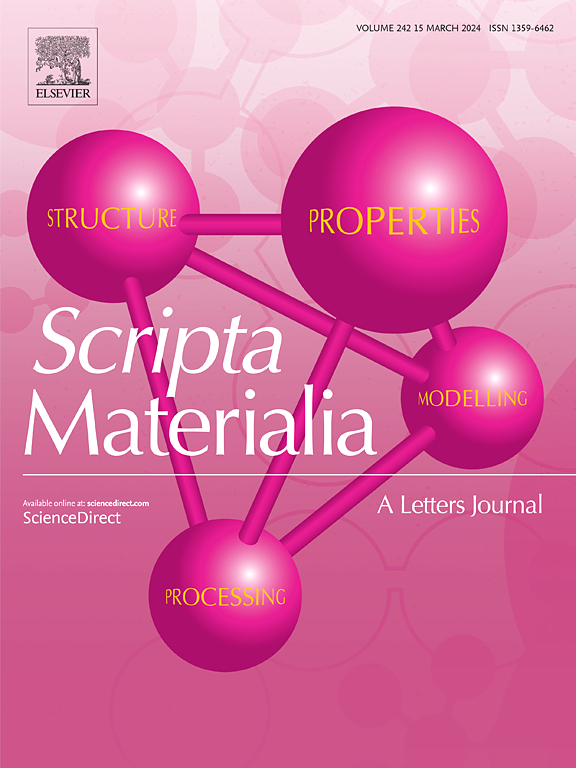激光基粉末床熔合加工亚稳β Ti-5Al-5Mo-5V-3Cr合金的变形扭结和应力诱导马氏体相变
IF 5.6
2区 材料科学
Q2 MATERIALS SCIENCE, MULTIDISCIPLINARY
引用次数: 0
摘要
采用扫描电镜、透射电镜和像差校正扫描电镜研究了激光粉末床熔合法制备的亚稳态β Ti-5Al-5Mo-5V-3Cr (wt.%, Ti-5553)合金的变形机理。在室温下,PBF-LB/M Ti-5553的极限抗拉强度为790.2±42.4 MPa,总伸长率为23.0%±1.4%,但有明显的应变软化。与传统加工Ti-5553中的变形孪晶不同,PBF-LB/M Ti-5553在拉伸变形过程中发生变形扭结,并形成与β基体相对于~ 2°至~ 11°的<;110>;β型扭结带。这些扭结带适应在拉伸变形过程中产生的局部应力集中,提高了总伸长率。此外,在扭结/基体界面和扭结带内形成具有正交结构的纳米级应力诱导α′′马氏体,进一步适应局部应变。变形扭结和应力诱导马氏体相变的结合被认为是PBF-LB/M Ti-5553在应变软化下仍具有良好延展性的原因。本文章由计算机程序翻译,如有差异,请以英文原文为准。

Deformation kinking and stress-induced martensitic transformation in a laser-based powder bed fusion-processed metastable β Ti-5Al-5Mo-5V-3Cr alloy
The deformation mechanism in a metastable β Ti-5Al-5Mo-5V-3Cr (wt.%, Ti-5553) alloy fabricated by laser-based powder bed fusion (PBF-LB/M) was investigated using scanning electron microscopy, transmission electron microscopy, and aberration-corrected scanning transmission electron microscopy. The PBF-LB/M Ti-5553 exhibited an ultimate tensile strength of 790.2 42.4 MPa and total elongation of 23.0 % 1.4 % at room temperature, despite notable strain softening. Unlike deformation twinning in conventionally processed Ti-5553, deformation kinking occurred in the PBF-LB/M Ti-5553 during tensile deformation and <110>β-type kink bands formed with ∼2° to ∼11° misorientation relative to the β matrix. These kink bands accommodate local stress concentrations developed during tensile deformation, enhancing the total elongation. Additionally, nanoscale stress-induced αʺ martensite with orthorhombic structure formed at kink/matrix interfaces and within kink bands, further accommodating localized strain. The combination of deformation kinking and stress-induced martensitic transformation is believed to contribute to the excellent ductility despite strain-softening in PBF-LB/M Ti-5553.
求助全文
通过发布文献求助,成功后即可免费获取论文全文。
去求助
来源期刊

Scripta Materialia
工程技术-材料科学:综合
CiteScore
11.40
自引率
5.00%
发文量
581
审稿时长
34 days
期刊介绍:
Scripta Materialia is a LETTERS journal of Acta Materialia, providing a forum for the rapid publication of short communications on the relationship between the structure and the properties of inorganic materials. The emphasis is on originality rather than incremental research. Short reports on the development of materials with novel or substantially improved properties are also welcomed. Emphasis is on either the functional or mechanical behavior of metals, ceramics and semiconductors at all length scales.
 求助内容:
求助内容: 应助结果提醒方式:
应助结果提醒方式:


